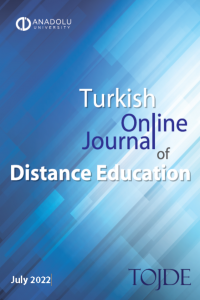Abstract
References
- Abdous, M. (2019). Influence of satisfaction and preparedness on online students’ feelings of anxiety. The Internet and Higher Education, 41, 34-44. https://doi.org/10.1016/j.iheduc.2019.01.001
- Allen, I. E., & Seaman, J. (2010b). Learning on demand: Online education in the United States, 2009. Babson Park, MA: Babson Survey Research Group. Retrieved from http:// sloanconsortium.org/sites/ default/files/pages/learningondemand-7.pdf
- Alqurashi, E. (2016). Self-efficacy in online learning environments: A literature review. Contemporary Issues in Education Research, 9(1), 45-52. https://doi.org/10.19030/cier.v9i1.9549
- Aman, R. R. (2009). Improving student satisfaction and retention with online instruction through systematic faculty peer review of courses. (Unpublished doctoral dissertation). Oregon State University.
- Appleton-Knapp, S. L., & Krentler, K. A. (2006). Measuring student expectations and their effects on satisfaction: the importance of managing student expectations. Journal of Marketing Education, 28(3), 254-264. https://doi.org/10.1177/0273475306293359
- Bandura, A. (1988). Self-efficacy conception of anxiety. Anxiety Research, 1(2), 77-98. https://doi. org/10.1080/10615808808248222
- Banks, A. C. & Faul, A. C. (2007). Reduction of face-to-face contact hours in foundation research courses: Impact on student knowledge gained and course satisfaction. Social Work Education, 26(8), 780- 793. https://doi.org/10.1080/02615470601140500
- Beckers, J. J., & Schmidt, H. G. (2001). The structure of computer anxiety: A six factor model. Computers in Human Behavior, 17, 35-49. doi: 10.1016/S0747-5632(00)00036-4
- Belanger, F., & Jordan, D. H. (2000). Evaluation and implementation of distance learning: Technologies, tools and techniques. Idea Publishing Group.
A MIXED-METHODS STUDY OF THE CORRELATION BETWEEN IRANIAN UNIVERSITY STUDENTS’ SATISFACTION AND ANXIETY IN ONLINE CLASSESS DURING THE COVID-19 PANDEMIC
Abstract
The present study aims to investigate the correlation between university students’ satisfaction and anxiety in online classes during the COVID-19 pandemic in Iran. To this aim, using a random sampling method, a sample of 430 male (n=150) and female (n=230) university students were selected at Ayatollah Borujerdi University. They filled out two questionnaires: one measuring their satisfaction and the other one measuring their anxiety in online classes. To triangulate the quantitative data, 22 university students completed a reflective written statement. To analyze the collected data, a Pearson correlation analysis, a multiple regression analysis, and a thematic coding analysis were used. Findings evidenced a moderate negative correlation between the participants’ satisfaction and anxiety in online classes. Additionally, results documented that instructor, technology, and outcomes factors had the largest effects on the participants’ anxiety in online classes. Complementary with the quantitative findings, the results of the reflective written statements yielded four overarching themes, including ‘instructors are facilitators’, ‘technology makes learning easier’, ‘outcomes are more promising’, and ‘interacting with others is poor’. Finally, in light of the findings, a range of implications is suggested.
Keywords
Satisfaction anxiety online classes the COVID-19 pandemic university students thematic coding analysis
References
- Abdous, M. (2019). Influence of satisfaction and preparedness on online students’ feelings of anxiety. The Internet and Higher Education, 41, 34-44. https://doi.org/10.1016/j.iheduc.2019.01.001
- Allen, I. E., & Seaman, J. (2010b). Learning on demand: Online education in the United States, 2009. Babson Park, MA: Babson Survey Research Group. Retrieved from http:// sloanconsortium.org/sites/ default/files/pages/learningondemand-7.pdf
- Alqurashi, E. (2016). Self-efficacy in online learning environments: A literature review. Contemporary Issues in Education Research, 9(1), 45-52. https://doi.org/10.19030/cier.v9i1.9549
- Aman, R. R. (2009). Improving student satisfaction and retention with online instruction through systematic faculty peer review of courses. (Unpublished doctoral dissertation). Oregon State University.
- Appleton-Knapp, S. L., & Krentler, K. A. (2006). Measuring student expectations and their effects on satisfaction: the importance of managing student expectations. Journal of Marketing Education, 28(3), 254-264. https://doi.org/10.1177/0273475306293359
- Bandura, A. (1988). Self-efficacy conception of anxiety. Anxiety Research, 1(2), 77-98. https://doi. org/10.1080/10615808808248222
- Banks, A. C. & Faul, A. C. (2007). Reduction of face-to-face contact hours in foundation research courses: Impact on student knowledge gained and course satisfaction. Social Work Education, 26(8), 780- 793. https://doi.org/10.1080/02615470601140500
- Beckers, J. J., & Schmidt, H. G. (2001). The structure of computer anxiety: A six factor model. Computers in Human Behavior, 17, 35-49. doi: 10.1016/S0747-5632(00)00036-4
- Belanger, F., & Jordan, D. H. (2000). Evaluation and implementation of distance learning: Technologies, tools and techniques. Idea Publishing Group.
Details
| Primary Language | English |
|---|---|
| Journal Section | Articles |
| Authors | |
| Publication Date | July 1, 2022 |
| Submission Date | August 14, 2021 |
| Published in Issue | Year 2022 Volume: 23 Issue: 3 |


